“The Northern onslaught upon slavery is no more than a piece of specious humbug disguised to conceal its desire for economic control of the United States.” ~ Charles Dickens
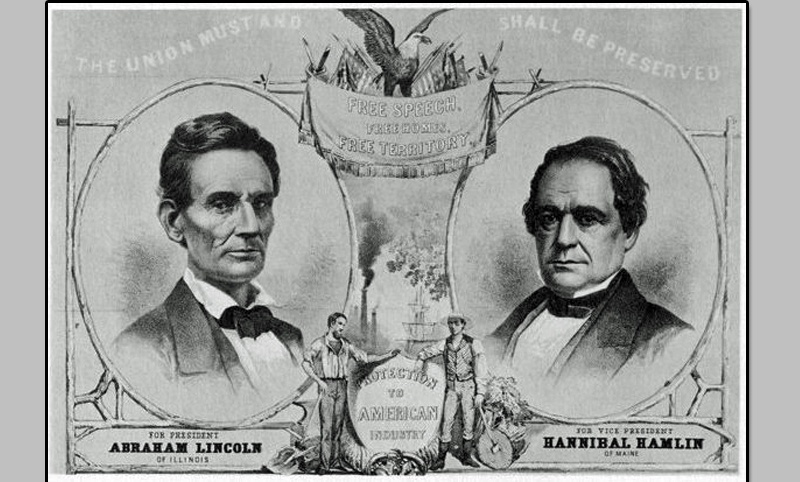 Most Americans believe the U. S. “Civil War” was over slavery. They have to an enormous degree been miseducated. The means and timing of handling the slavery question were at issue, although not in the overly simplified moral sense that lives in postwar and modern propaganda. But had there been no Morrill Tariff there might never have been a war. The conflict that cost of the lives of 650,000 Union and Confederate soldiers and perhaps as many as 50,000 Southern civilians and impoverished many millions for generations might never have been.
Most Americans believe the U. S. “Civil War” was over slavery. They have to an enormous degree been miseducated. The means and timing of handling the slavery question were at issue, although not in the overly simplified moral sense that lives in postwar and modern propaganda. But had there been no Morrill Tariff there might never have been a war. The conflict that cost of the lives of 650,000 Union and Confederate soldiers and perhaps as many as 50,000 Southern civilians and impoverished many millions for generations might never have been.
A smoldering issue of unjust taxation that enriched Northern manufacturing states and exploited the agricultural South was fanned to a furious blaze in 1860. It was the Morrill Tariff that stirred the smoldering embers of regional mistrust and ignited the fires of Secession in the South. This precipitated a Northern reaction and call to arms that would engulf the nation in the flames of war for four years.
Prior to the U. S. “Civil War” there was no U. S. income tax. In 1860, approximately 95% of U. S. government revenue was raised by a tariff on imported goods. A tariff is a tax on selected imports, most commonly finished or manufactured products. A high tariff is usually legislated not only to raise revenue, but also to protect domestic industry form foreign competition. By placing such a high, protective tariff on imported goods it makes them more expensive to buy than the same domestic goods. This allows domestic industries to charge higher prices and make more money on sales that might otherwise be lost to foreign competition because of cheaper prices (without the tariff) or better quality. This, of course, causes domestic consumers to pay higher prices and have a lower standard of living. Tariffs on some industrial products also hurt other domestic industries that must pay higher prices for goods they need to make their products. Because the nature and products of regional economies can vary widely, high tariffs are sometimes good for one section of the country, but damaging to another section of the country. High tariffs are particularly hard on exporters since they must cope with higher domestic costs and retaliatory foreign tariffs that put them at a pricing disadvantage. This has a depressing effect on both export volume and profit margins. High tariffs have been a frequent cause of economic disruption, strife and war.
Prior to 1824 the average tariff level in the U. S. had been in the 15 to 20 % range. This was thought sufficient to meet federal revenue needs and not excessively burdensome to any section of the country. The increase of the tariff to a 20% average in 1816 was ostensibly to help pay for the War of 1812. It also represented a 26% net profit increase to Northern manufacturers.
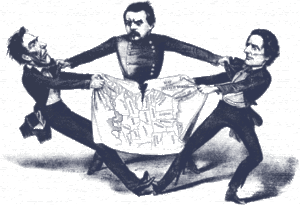 In 1824 Northern manufacturing states and the Whig Party under the leadership of Henry Clay began to push for high, protective tariffs. These were strongly opposed by the South. The Southern economy was largely agricultural and geared to exporting a large portion of its cotton and tobacco crops to Europe. In the 1850’s the South accounted for anywhere from 72 to 82% of U. S. exports. They were largely dependent, however, on Europe or the North for the manufactured goods needed for both agricultural production and consumer needs. Northern states received about 20% of the South’s agricultural production. The vast majority of export volume went to Europe. A protective tariff was then a substantial benefit to Northern manufacturing states, but meant considerable economic hardship for the agricultural South
In 1824 Northern manufacturing states and the Whig Party under the leadership of Henry Clay began to push for high, protective tariffs. These were strongly opposed by the South. The Southern economy was largely agricultural and geared to exporting a large portion of its cotton and tobacco crops to Europe. In the 1850’s the South accounted for anywhere from 72 to 82% of U. S. exports. They were largely dependent, however, on Europe or the North for the manufactured goods needed for both agricultural production and consumer needs. Northern states received about 20% of the South’s agricultural production. The vast majority of export volume went to Europe. A protective tariff was then a substantial benefit to Northern manufacturing states, but meant considerable economic hardship for the agricultural South
Northern political dominance enabled Clay and his allies in Congress to pass a tariff averaging 35% late in 1824. This was the cause of economic boom in the North, but economic hardship and political agitation in the South. South Carolina was especially hard hit, the State’s exports falling 25% over the next two years. In 1828 in a demonstration of unabashed partisanship and unashamed greed the Northern dominated Congress raised the average tariff level to 50%. Despite strong Southern agitation for lower tariffs the Tariff of 1832 only nominally reduced the effective tariff rate and brought no relief to the South. These last two tariffs are usually termed in history as the Tariffs of Abomination.
This led to the Nullification Crisis of 1832 when South Carolina called a state convention and “nullified” the 1828 and 1832 tariffs as unjust and unconstitutional. The resulting constitutional crisis came very near provoking armed conflict at that time. Through the efforts of former U. S. Vice President and U. S. Senator from South Carolina, John C. Calhoun, a compromise was effected in 1833 which over a few years reduced the tariff back to a normal level of about 15%. Henry Clay and the Whigs were not happy, however, to have been forced into a compromise by Calhoun and South Carolina’s Nullification threat. The tariff, however, remained at a level near 15% until 1860. A lesson in economics, regional sensitivities, and simple fairness should have been learned from this confrontation, but if it was learned, it was ignored by ambitious political and business factions and personalities that would come on the scene of American history in the late 1850’s.
High protective tariffs were always the policy of the old Whig Party and had become the policy of the new Republican Party that replaced it. A recession beginning around 1857 gave the cause of protectionism an additional political boost in the Northern industrial states.
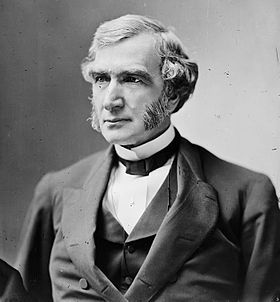
Justin S. Morrill
In May of 1860 the U. S. Congress passed the Morrill Tariff Bill (named for Republican Congressman and steel manufacturer, Justin S. Morrill of Vermont) raising the average tariff from about 15% to 37% with increases to 47% within three years. Although this was remarkably reminiscent of the Tariffs of Abomination which had led in 1832 to a constitutional crisis and threats of secession and armed force, the U. S. House of Representatives passed the Bill 105 to 64. Out of 40 Southern Congressmen only one Tennessee Congressman voted for it.
U. S. tariff revenues already fell disproportionately on the South, accounting for 87% of the total even before the Morrill Tariff. While the tariff protected Northern industrial interests, it raised the cost of living and commerce in the South substantially. It also reduced the trade value of their agricultural exports to Europe. These combined to place a severe economic hardship on many Southern states. Even more galling was that 80% or more of these tax revenues were expended on Northern public works and industrial subsidies, thus further enriching the North at the expense of the South.
In the 1860 election, Lincoln, a former Whig and great admirer of Henry Clay, campaigned for the high protective tariff provisions of the Morrill Tariff, which had also been incorporated into the Republican Party Platform. Thaddeus Stevens, the most powerful Republican in Congress and one of the co-sponsors of the Morrill Tariff, told an audience in New York City on September 27, 1860, that the two most important issues of the Presidential campaign were preventing the extension of slavery to new states and an increase in the tariff, but that the most important of the two was increasing the tariff. Stevens, a Pennsylvania iron manufacturer, was also one of the most radical abolitionists in Congress. He told the New York audience that the tariff would enrich the northeastern states and impoverish the southern and western states, but that it was essential for advancing national greatness and the prosperity of industrial workers. Stevens, who would become virtually the “boss’ of America after the assassination of Lincoln, advised the crowd that if Southern leaders objected, they would be rounded up and hanged.
Two days before Lincoln’s election in November of 1860, an editorial in the Charleston Mercury summed up the feeling of South Carolina on the impending national crisis:
“The real causes of dissatisfaction in the South with the North, are in the unjust taxation and expenditure of the taxes by the Government of the United States, and in the revolution the North has effected in this government, from a confederated republic, to a national sectional despotism.”
With the election of Lincoln and strengthened Northern dominance in Congress, Southern leaders in South Carolina and the Gulf states began to call for Secession. Lincoln endorsed the Morrill Tariff in his inaugural speech and promised to enforce it even on seceding Southern states. He signed the Act into law a few days after taking office in March of 1861. The South was filled with righteous indignation.
At first Northern public opinion as reflected in Northern newspapers of both parties recognized the right of the Southern States to secede and favored peaceful separation. A November 21, 1860, editorial in the Cincinnati Daily Press said this:
“We believe that the right of any member of this Confederacy to dissolve its political relations with the others and assume an independent position is absolute.”
The New York Times on March 21, 1861, reflecting the great majority of editorial opinion in the North summarized in an editorial:
“There is a growing sentiment throughout the North in favor of letting the Gulf States go.”
Northern industrialists became nervous, however, when they realized a tariff dependent North would be competing against a free-trade South. They feared not only loss of tax revenue, but considerable loss of trade. Newspaper editorials began to reflect this nervousness. Events in April would engulf the nation in cataclysmic war.
Lincoln met secretly on April 4, 1861, with Colonel John Baldwin, a delegate to the Virginia Secession Convention. Baldwin, like a majority of that convention would have preferred to keep Virginia in the Union. But Baldwin learned at that meeting that Lincoln was already committed to taking some military action at Fort Sumter in South Carolina. He desperately tried to persuade Lincoln that military action against South Carolina would mean war and also result in Virginia’s secession. Baldwin tried to persuade Lincoln that if the Gulf States were allowed to secede peacefully, historical and economic ties would eventually persuade them to reunite with the North. Lincoln’s decisive response was,
“And open Charleston, etc. as ports of entry with their ten percent tariff? What then would become of my tariff?”
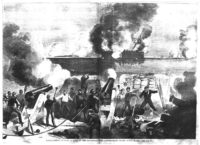
Bombardment of Fort Sumter
Despite Colonel Baldwin’s advice, on April 12, 1861, Lincoln manipulated the South into firing on the tariff collection facility of Fort Sumter in volatile South Carolina. This achieved an important Lincoln objective. Northern opinion was now enflamed against the South for “firing on the flag.” Three days later Lincoln called for 75,000 volunteers to put down the Southern “rebellion”. This caused the Border States to secede along with the Gulf States. Lincoln undoubtedly calculated that the mere threat of force backed by a now more unified Northern public opinion would quickly put down secession. His gambit, however, failed spectacularly and would erupt into a terrible and costly war for four years.
Shortly after Lincoln’s call to put down the “rebellion;” a prominent Northern politician wrote to Colonel Baldwin to enquire what Union men in Virginia would do now. His response was:
“There are now no Union men in Virginia. But those who were Union men will stand to their arms, and make a fight which shall go down in history as an illustration of what a brave people can do in defense of their liberties, after having exhausted every means of pacification.”
The Union Army’s lack of success early in the war, the need to keep anti-slavery England from coming into the war on the side of the South, and Lincoln’s need to appease the radical abolitionists in the North led to increasing promotion of freeing the slaves as a noble cause to justify what was really a dispute over fair taxation and States Rights.
Writing in December of 1861 in a London weekly publication, the famous English author, Charles Dickens, who was a strong opponent of slavery, said these things about the war going on in America:
“The Northern onslaught upon slavery is no more than a piece of specious humbug disguised to conceal its desire for economic control of the United States.”
Karl Marx, like most European socialists of the time favored the North. In an 1861 article published in England, he articulated very well what the major British newspapers, the Times, the Economist, and Saturday Review, had been saying:
“The war between the North and South is a tariff war. The war, is further, not for any principle, does not touch the question of slavery, and in fact turns on the Northern lust for power.”
The Tariff question and the States Rights question were therefore strongly linked. Both are linked to the broader issues of limited government and a strong Constitution. The Morrill Tariff dealt the South a flagrant political injustice and impending economic hardship and crisis. It therefore made Secession a very compelling alternative to an exploited and unequal union with the North.
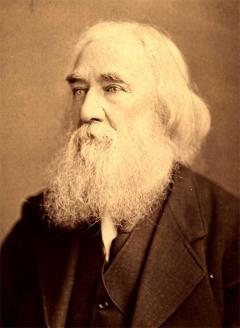
Lysander Spooner
How to handle the slavery question was an underlying tension between North and South, but one of many tensions. It cannot be said to be the cause of the war. Fully understanding the slavery question and its relations to those tensions is beyond the scope of this article, but numerous historical facts demolish the propagandistic morality play that a virtuous North invaded the evil South to free the slaves. Five years after the end of the War, prominent Northern abolitionist, attorney and legal scholar, Lysander Spooner, put it this way:
“All these cries of having ‘abolished slavery,’ of having ‘saved the country,’ of having ‘preserved the Union,’ of establishing a ‘government of consent,’ and of ‘maintaining the national honor’ are all gross, shameless, transparent cheats—so transparent that they ought to deceive no one.”
Yet apparently many today are still deceived and even prefer to be deceived.
The Southern states had seen that continued union with the North would jeopardize their liberties and economic well-being. Through the proper constitutional means of state conventions and referendums they sought to withdraw from the Union and establish their independence just as the American Colonies had sought their independence from Great Britain in 1776 and for very similar reasons. The Northern industrialists, however, were not willing to give up their Southern Colonies.
In addition to the devastating loss of life and leadership during the War, the South suffered considerable damage to property, livestock, and crops. The policies of “Reconstruction” and “carpetbagger” state governments further exploited and robbed the South, considerably retarding economic recovery. Further, high tariffs and discriminatory railroad shipping taxes continued to favor Northern economic interests and impoverish the South for generations after the war. It is only in relatively recent history that the political and economic fortunes of the South have begun to rise.
Unjust taxation has been the cause of many tensions and much bloodshed throughout history. The Morrill Tariff was certainly a powerful factor predisposing the South to seek its independence and determine its own destiny. As outrageous and unjust as the Morrill Tariff was, its importance has been largely ignored and even purposely obscured. It does not fit the politically correct images and myths of popular American history. Truth, however, is always the high ground. It will have the inevitable victory
Had it not been for the Morrill Tariff there would have been no rush to Secession by Southern states and very probably no war. The Morrill Tariff of 1860, so unabashed and unashamed in its short-sighted, partisan greed, stands as an astonishing monument to the self-centered depravity of man and to its consequences. No wonder most Americans would like to see it forgotten and covered over with a more morally satisfying but largely false version of the causes of the Uncivil War.
RELATED: The Morrill Tariff of 1861: The True Cause of Secession and the War of Northern Aggression
The OTHER Side: Debunking the Civil War Tariff Myth
Written by Mike Scruggs for the Tribune Papers, Asheville and Henderson, NC ~ January 5, 2014
FAIR USE NOTICE: This site contains copyrighted material the use of which has not always been specifically authorized by the copyright owner. We are making such material available in our efforts to advance understanding of environmental, political, human rights, economic, democracy, scientific, and social justice issues, etc. We believe this constitutes a ‘fair use’ of any such copyrighted material as provided for in section 107 of the US Copyright Law. In accordance with Title 17 U. S. C. Section 107, the material on this site is distributed without profit to those who have expressed a prior interest in receiving the included information for research and educational purposes. For more information go to: http://www.law.cornell.edu/uscode/17/107.shtml

Pingback: Are Donald Trump’s Threat Of New Tariffs Just As Radical Of… – OMC Radio TV